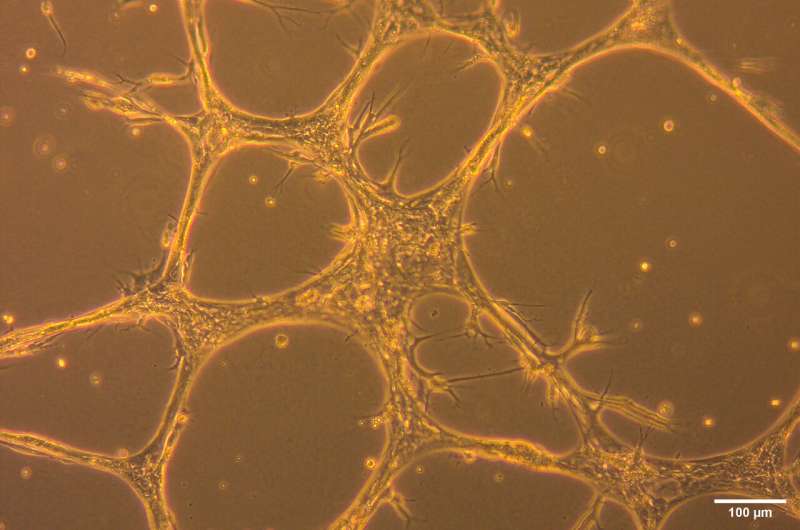This article has been reviewed according to Science X's editorial process and policies. Editors have highlighted the following attributes while ensuring the content's credibility:
fact-checked
peer-reviewed publication
trusted source
proofread
Two keys needed to crack three locks for better engineered blood vessels

Blood vessels engineered from stem cells could help solve several research and clinical problems, from potentially providing a more comprehensive platform to screen if drug candidates can cross from the blood stream into the brain to developing lab-grown vascular tissue to support heart transplants, according to Penn State researchers.
Led by Xiaojun "Lance" Lian, associate professor of biomedical engineering and of biology, the team discovered the specific molecular signals that can efficiently mature nascent stem cells into the endothelial cells that comprise the vessels and regulate exchanges to and from the blood stream.
The researchers have published their findings in Stem Cell Reports. The team already holds a patent on foundational method developed 10 years ago and has filed a provisional application for the expanded technology described in this paper.
The researchers found they could achieve up to a 92% endothelial cell conversion rate by applying two proteins—SOX17 and FGF2—to human pluripotent stem cells. This type of stem cell, which the researchers derived from a federally approved stem cell line, can differentiate into almost any other cell type if provided the right proteins or other biochemical signals. SOX17 and FGF2 engage three markers in stem cells, triggering a growth cascade that not only converts them to endothelial cells but also enables them to form tubular-like vessels in a dish.
The more efficient differentiation and lab-grown vessels could allow researchers to grow an artificial blood brain barrier to test neurological drugs under development, according to Lian. Other eventual clinical uses may include reestablishing vascular structures after heart damage.
"Drugs designed to treat brain diseases need to pass through the blood brain barrier to be effective," Lian said. The blood brain barrier is a membrane packed with vessels and regulates what can pass from the blood into the brain. "Our cells can form a tight layer in a dish, onto which we could add various chemicals and see how they pass through."
Next, Lian said, the team will collaborate with industry partners to advance the artificial blood brain barrier and begin testing various drugs. Getting to this point, however, required a decade of investigating the molecular mechanism underpinning how stem cells convert to endothelial cells.
"In 2014, we published a protocol using a small molecule that could help the cells differentiate about 20% of the time, but we've now found that just one gene, SOX17, is sufficient for differentiating the about 80% of cells into endothelial cells," said Lian. "That was completely unknown."
In their prior stem cell differentiation process, the low efficiency resulted in heterogenous cell populations, making them difficult to sort and to obtain enough for other research or clinical applications. Lian explained that the researchers knew some of the cells were endothelial cells, but they couldn't predict the other cell types.
To make more homogenous populations, the researchers examined the proteins at play during the process. They first noticed that cells expressed SOX17 during differentiation, so they removed the cells' ability to express the protein and analyzed how its absence changed function.
"Before knocking down SOX17 expression, about 20% of stem cells would become endothelial cells," Lian said "After, differentiation dropped to about 5% at best. We found that SOX17 is required for this process. It was a lucky and surprising finding."
With the addition of SOX17, 80% of stem cells could differentiate. But the researchers wanted to do better, Lian said. The stem cells produce three markers, but SOX17 only triggers two of them to begin the differentiation process. The third marker, called CD31, doesn't work when only exposed to SOX17.
"That was a problem for us. We spent two to three years figuring out why," Lian said, explaining that another protein, called FGF2 could induce the marker without affecting SOX17's influence on the other two markers. The combination results in up to 92% of the stem cells differentiating into endothelial cells—a more than 350% increase in efficiency from the researchers' original approach. "Sometimes science is very difficult, but we do not give up."
With all three markers activated, the differentiated cells can form tubular-like vessels in a dish. They can also uptake proteins, like blood vessels in the body. The researchers tested this ability by inducing inflammation to see if the endothelial cells could detect the protein signal involved—they could.
"Our cells are indeed functional," Lian said. "With SOX17 and FGF2, we can determine the fate of these stem cells to be precisely what we need."
More information: Michael W. Ream et al, Direct programming of human pluripotent stem cells into endothelial progenitors with SOX17 and FGF2, Stem Cell Reports (2024). DOI: 10.1016/j.stemcr.2024.02.006
Journal information: Stem Cell Reports
Provided by Pennsylvania State University





















